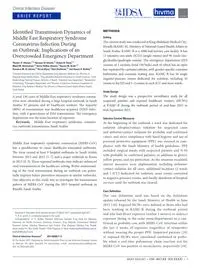
2017 Identified Transmission Dynamics of Middle East Respiratory Syndrome Coronavirus Infection During an Outbreak_ Impl PDF
Preview 2017 Identified Transmission Dynamics of Middle East Respiratory Syndrome Coronavirus Infection During an Outbreak_ Impl
Clinical Infectious Diseases • CID 2017:XX (XX XXXX) • 1 BRIEF REPORT Identified Transmission Dynamics of Middle East Respiratory Syndrome Coronavirus Infection During an Outbreak: Implications of an Overcrowded Emergency Department Thamer H. Alenazi,1,2,a Hussain Al Arbash,3,a Aiman El-Saed,1,2 Majid M. Alshamrani,1,2 Henry Baffoe-Bonnie,1 Yaseen M. Arabi,2,4 Sameera M. Al Johani,2,5 Ra’ed Hijazi,6 Adel Alothman,2,7 and Hanan H. Balkhy1,2 1Infection Prevention and Control Department, King Abdulaziz Medical City, Ministry of National Guard Health Affairs, 2King Saud Bin Abdulaziz University for Health Sciences, 3Field Epidemiology Training Program, Ministry of Health, 4Intensive Care Department, 5Department of Pathology, 6Emergency Department, and 7Division of Infectious Diseases, Depatment of Medicine, King Abdulaziz Medical City, Ministry of National Guard Health Affairs, Riyadh, Saudi Arabia A total 130 cases of Middle East respiratory syndrome corona- virus were identified during a large hospital outbreak in Saudi Arabia; 87 patients and 43 healthcare workers. The majority (80%) of transmission was healthcare-acquired (HAI) infec- tion, with 4 generations of HAI transmission. The emergency department was the main location of exposure. Keywords. Middle East respiratory syndrome; coronavi- rus; outbreak; transmission; Saudi Arabia. Middle East respiratory syndrome coronavirus (MERS-CoV) has a predilection to cause healthcare-associated outbreaks. The virus caused at least 9 hospital outbreaks in Saudi Arabia between 2013 and 2015 [1–7] and a major outbreak in Korea in 2015 [8, 9]. These repeated outbreaks may indicate enhanced viral transmission in the healthcare setting. Better understand- ing of the viral transmission during an outbreak can poten- tially improve future preventive measures in similar outbreaks. Our objective in this study was to investigate the transmission pattern of MERS-CoV during the 2015 hospital outbreak in Riyadh, Saudi Arabia. METHODS Setting The current study was conducted at King Abdulaziz Medical City- Riyadh (KAMC-R), Ministry of National Guard Health Affairs in Saudi Arabia. KAMC-R is a 1000-bed tertiary care facility. It has 13 intensive care units (ICUs) (single-rooms) and 36 wards (sin- gle/double/quadruple rooms). The emergency department (ED) consists of 3 sections (total 150 beds) each of which has an open bay separated by curtains/cubicles, with gender-specific common bathrooms and common waiting area. KAMC-R has 56 single negative-pressure rooms dedicated for isolation, including 10 rooms in the ED and 1–2 rooms in each ICU and most wards. Study Design The study design was a prospective surveillance study for all suspected patients and exposed healthcare workers (HCWs) at KAMC-R during the outbreak period of mid-June 2015 to mid-September 2015. Infection Control Measures At the beginning of the outbreak a ward was dedicated for isolation (droplet/contact isolation for suspected cases and airborne/contact isolation for probable and confirmed cases), and strict compliance with hand hygiene and use of personal protective equipment (PPE) was stressed in com- pliance with the Saudi Ministry of health guidelines. PPE included surgical masks with suspected patients and N-95 with probable or confirmed patients, in addition to gloves, yellow gowns, and eye protection. As the situation escalated, stricter measures were implemented, including airborne/ contact isolation for all cases, additional locations (2 wards and 1 ICU) dedicated for isolation, more rooms converted to negative-pressure rooms, and finally shutdown of hospital services until the outbreak was cleared. Case Definition The case definition used was based on the definition update released by the Saudi Ministry of Health in June 2015 [10]. Exposed HCWs were defined as those who had been working in KAMC-R during the outbreak period and who had direct exposure (within 2 meters) or indirect exposure (being in the same room/department) to a con- firmed or probable case with MERS-CoV infection within the last 2 weeks of exposure (regardless of symptoms) without wearing the proper PPE. Suspected patients [10] or exposed HCWs were considered confirmed or proba- ble when a real-time polymerase chain reaction test for MERS-CoV was positive or inconclusive, respectively [10]. B R I E F R E P O R T © The Author 2017. Published by Oxford University Press for the Infectious Diseases Society of America. All rights reserved. For permissions, e-mail:
